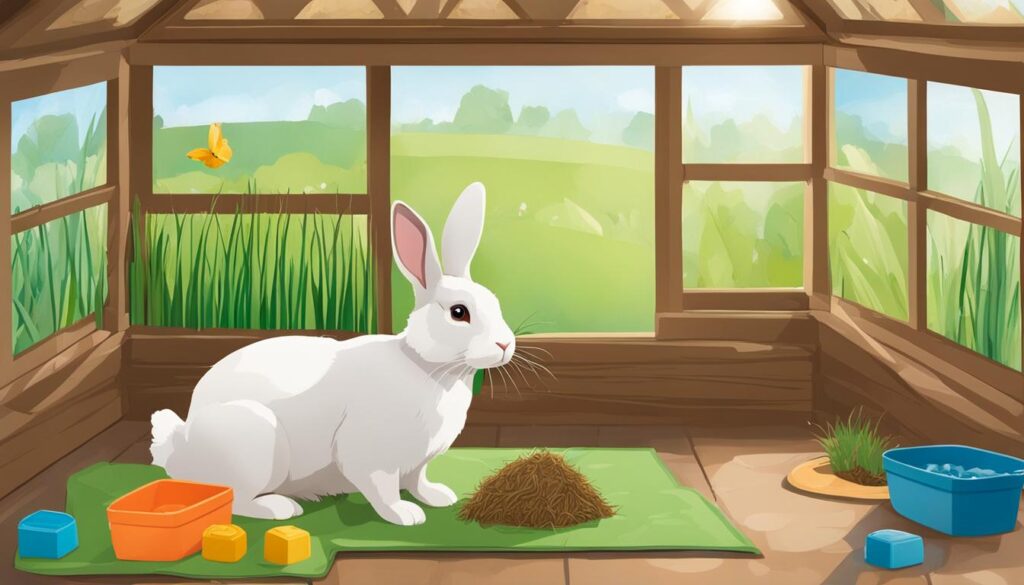When it comes to creating a comfortable living space for your beloved rabbits, you have the option of setting up their habitat either indoors or outdoors. Each choice comes with its own set of benefits and considerations. Let’s explore the factors you should consider to provide optimal living conditions for your furry companions.
Indoor rabbit housing has been gaining popularity due to its ability to ensure the safety and socialization of your rabbits. By keeping them indoors, you protect them from predators, parasites, and extreme temperatures. Indoor rabbits also have the opportunity for better socialization, leading to a longer and happier life. However, it’s important to create a rabbit-proofed home and provide proper care to ensure their well-being.
On the other hand, outdoor rabbit housing offers a more natural environment for rabbits, allowing them to engage in their instinctual behaviors such as digging, burrowing, and exploring. Outdoor rabbits have more space for exercise and are not confined to a cage. However, they are exposed to dangers such as predators, parasites, and weather fluctuations, which can pose risks to their health and safety.
Whether you choose to provide your rabbits with indoor or outdoor housing, it’s crucial to consider their space requirements, weather conditions, interaction with other pets, and fulfillment of their natural behaviors. Ultimately, the comfort, safety, and well-being of your rabbits should be the top priority when deciding on the best habitat for them.
In the following sections, we will delve deeper into the specific benefits, considerations, and requirements of indoor and outdoor rabbit housing. By understanding these factors, you will be equipped to create the most comfortable and suitable living conditions for your furry friends.
The Dangers of the Outdoors for Rabbits
Outdoor living poses several dangers for rabbits that can put their safety and well-being at risk. One of the primary hazards is the presence of predators. Outdoor rabbits are vulnerable to attacks from animals such as raccoons, dogs, foxes, cats, hawks, and coyotes. The mere presence of these predators can cause fear and anxiety in rabbits, affecting their overall quality of life.
In addition to predators, outdoor rabbits are also exposed to various parasites that can pose health risks. Ticks, fleas, mosquitoes, and mites are common in outdoor environments and can infest rabbits, leading to discomfort, disease transmission, and potential health issues.
Extreme weather conditions can be particularly dangerous for outdoor rabbits. In hot temperatures, rabbits can suffer from heat stroke, dehydration, and other heat-related illnesses. On the other hand, freezing temperatures can lead to hypothermia and frostbite, potentially causing severe harm or even death to rabbits. These extreme weather risks make outdoor living unsuitable for rabbits, as they lack the ability to regulate their body temperature effectively in such conditions.
Outdoor Hazards for Rabbits
| Hazard | Description |
|---|---|
| Predators | Raccoons, dogs, foxes, cats, hawks, coyotes |
| Parasites | Ticks, fleas, mosquitoes, mites |
| Extreme Weather | Heat stroke, dehydration, hypothermia, frostbite |
Given these hazards, providing a safe and secure indoor environment for rabbits is a preferable option. Indoor housing allows for better protection from predators and parasites, as well as control over temperature and other environmental factors. Considerations for indoor rabbit housing will be discussed in the following section.
The Benefits of Indoor Rabbit Housing
When it comes to providing a safe and comfortable living space for your rabbits, indoor housing offers numerous benefits. One of the key advantages is the opportunity for companionship and socialization with your rabbits. Indoor rabbits become accustomed to human interaction and can form strong bonds with their caretakers, leading to happier and more well-adjusted pets.
Additionally, indoor rabbit housing ensures the safety of your furry friends. By keeping them indoors, you greatly reduce their exposure to potential predators such as raccoons, dogs, and hawks. This provides peace of mind and minimizes the risk of your rabbits experiencing fear or anxiety from the presence of these predators.
Another important aspect of indoor rabbit housing is the ability to closely monitor your rabbits’ health and well-being. In an indoor environment, you can easily observe any changes in behavior, appetite, or litter box habits, allowing you to promptly address any potential health issues. Regular veterinary care is more accessible, ensuring that your rabbits receive the necessary medical attention.
Creating a Safe Indoor Habitat
To provide the best indoor housing for your rabbits, it’s essential to create a well-designed and rabbit-proofed environment. Consider the following tips:
- Choose a spacious cage or enclosure that allows your rabbits to move around comfortably.
- Provide plenty of hiding places and cozy spots for your rabbits to retreat to when they need privacy or feel anxious.
- Ensure proper ventilation to maintain good air quality and prevent the buildup of ammonia from urine.
- Use safe and rabbit-friendly bedding materials, such as hay or paper-based products.
- Regularly clean the enclosure to maintain proper hygiene and prevent the accumulation of waste and odors.
By creating a safe and enriching indoor habitat for your rabbits, you can ensure their overall well-being and provide them with a happy and comfortable living space.
| Benefits of Indoor Rabbit Housing |
|---|
| Companionship and socialization opportunities |
| Enhanced safety from predators |
| Close monitoring of health and easy access to veterinary care |
| Comfortable and well-designed living environment |
The Benefits of Outdoor Rabbit Housing
Outdoor rabbit housing offers numerous advantages for rabbits, allowing them to thrive in a more natural environment that caters to their behavioral needs and space requirements. With access to the outdoors, rabbits have the opportunity to engage in their instinctual behaviors such as digging, burrowing, chewing, and exploring. This stimulation is vital for their mental and physical well-being.
One of the key benefits of outdoor housing is the ample space it provides for rabbits to exercise and roam freely. In contrast to indoor cages, outdoor enclosures allow rabbits to hop, run, and play to their heart’s content. This additional space is particularly beneficial for larger breeds or when housing multiple rabbits in a colony setting.
While outdoor housing provides rabbits with a more natural environment, it is important to consider the potential risks involved. Rabbits in outdoor enclosures are more exposed to weather fluctuations, predators, and may have less interaction with their human caretakers. It is crucial to ensure that outdoor enclosures are secure, predator-proof, and provide adequate shade and protection from the elements to keep rabbits safe and healthy.
| Benefits of Outdoor Rabbit Housing |
|---|
| 1. Catering to natural behaviors |
| 2. Ample space for exercise |
| 3. Mental and physical stimulation |
| 4. Suitable for larger breeds or colonies |
Space and Living Requirements for Indoor Rabbits
Creating a comfortable living space for your indoor rabbits is essential for their overall well-being. Indoor rabbits require sufficient space for resting, exercise, and hiding. Here are some key considerations when it comes to space and living requirements for your indoor rabbits:
Indoor Rabbit Cage Space Requirements
Rabbits need enough space to move around comfortably within their cage. A general guideline is to provide at least four times their body length in living area. For example, if your rabbit measures 12 inches from head to tail, the cage should be at least 48 inches long. This will allow them to hop, stretch, and play.
Indoor Rabbit Resting Area
It’s important to provide a cozy and secure resting area for your indoor rabbits. The resting area should have at least two compartments – one for sleeping and one for eating/relaxing. Each compartment should be spacious enough for the rabbit to lie down and stretch out comfortably. Ensure the resting area is well-ventilated, dry, and free from any drafts.
Indoor Rabbit Exercise Area
Indoor rabbits need regular exercise to maintain their physical and mental well-being. Create an exercise area within their living space where they can hop, jump, and explore. The exercise area should be large enough for them to move around freely. Raised platforms or shelves can also provide additional opportunities for jumping and climbing.
Indoor Rabbit Hiding Places
Rabbits are naturally prey animals and require hiding places to feel secure. Provide suitable hiding spots within their living space, such as tunnels, boxes, or hideouts. These hiding places offer rabbits a sense of safety and privacy when they need some time alone. Hiding spots can also promote a sense of security and reduce stress in rabbits.
| Requirement | Indoor Rabbits |
|---|---|
| Cage Space | At least four times their body length |
| Resting Area | At least two compartments, well-ventilated, dry, and draft-free |
| Exercise Area | Large enough for hopping and movement, with raised platforms for jumping |
| Hiding Places | Tunnels, boxes, or hideouts for privacy and reducing stress |
By considering these space and living requirements, you can ensure your indoor rabbits have a comfortable and enriching habitat that promotes their health and happiness.
Housing Considerations for Outdoor Rabbits
When choosing outdoor housing for your rabbits, there are a few important factors to consider to ensure their comfort and safety.
Outdoor Rabbit Hutch Requirements
The outdoor rabbit hutch should be weatherproof, sturdy, and raised off the ground to keep it dry and prevent predators from easily accessing it. The hutch should have secure catches to prevent escape or theft.
Outdoor Rabbit Resting Area
Provide a protected resting area within the hutch that offers shelter from the elements and predators. This area should be comfortable, spacious enough for the rabbit to stretch out and lie down, and kept clean to maintain good hygiene.
Outdoor Rabbit Exercise Area
It is essential to provide an attached exercise run or a safe, enclosed space where rabbits can stretch their legs, hop, and engage in natural behaviors. This area should allow for ample movement and exploration to keep rabbits mentally stimulated and physically active.
Outdoor Rabbit Protection from Predators
Outdoor rabbits are vulnerable to predators such as raccoons, foxes, cats, and birds of prey. Ensure that the hutch is designed to keep predators out and provide additional protective measures, such as a sturdy wire mesh and secure locks.
Outdoor Rabbit Ventilation and Temperature Control
Proper ventilation is crucial to prevent heat buildup and maintain good air quality within the hutch. Ensure that there are adequate openings for fresh air circulation while still protecting rabbits from drafts. Additionally, consider providing shade during hot weather and insulation during colder months to help regulate the temperature inside the hutch.
| Outdoor Rabbit Hutch Requirements | Outdoor Rabbit Resting Area | Outdoor Rabbit Exercise Area | Outdoor Rabbit Protection from Predators | Outdoor Rabbit Ventilation and Temperature Control |
|---|---|---|---|---|
| Weatherproof, sturdy, and raised hutch | Comfortable and spacious resting area | Attached exercise run or enclosed space | Secure catches and protective measures | Adequate ventilation and temperature regulation |
Hygiene and Safety for Rabbit Housing
Ensuring proper hygiene and safety is essential for maintaining a healthy and comfortable living environment for your rabbits, whether they are housed indoors or outdoors. Regular cleaning and maintenance are key to preventing the buildup of dirt, bacteria, and odors.
For indoor rabbit housing, it is important to regularly clean the rabbit cage. Spot cleaning should be done daily to remove any soiled bedding, droppings, or spilled food. A thorough cleaning of the cage should be carried out weekly using a mild, rabbit-safe disinfectant. Ensure that the cage is rinsed well and completely dry before reintroducing your rabbits.
When it comes to outdoor rabbit housing, the hutch should be cleaned regularly to maintain hygiene. Remove any soiled bedding, droppings, or uneaten food from the hutch at least once a week. Ensure that the hutch is well-ventilated and protected from the elements. Regularly inspect the hutch for any signs of wear or damage, repairing or replacing any broken parts to prevent escape or injury.
Bedding materials play a crucial role in maintaining hygiene and comfort. Choose rabbit-safe bedding materials that are absorbent, dust-free, and non-toxic. Avoid using cedar or pine shavings, as the aromatic oils can be harmful to rabbits. Opt for alternatives such as paper-based bedding, hay, or straw. Regularly replace bedding to prevent the accumulation of waste and odors.
Protection from Poison and Hazards
It is important to protect your rabbits from potential hazards and toxins, both indoors and outdoors. Ensure that their living space is free from any toxic plants or substances that could harm them if ingested. Common household items such as cleaning products, pesticides, and certain houseplants can be poisonous to rabbits. Store these items securely out of reach or use rabbit-friendly alternatives.
Rabbit Travel Safety
When traveling with your rabbits, it is important to prioritize their safety and well-being. Use a secure and well-ventilated pet carrier that is appropriate for the size of your rabbits. Ensure that the carrier is properly secured in the vehicle to prevent accidents or injuries during transportation. Consider the temperature and provide access to fresh water to prevent dehydration. Avoid leaving your rabbits unattended in a vehicle, as extreme temperatures can be life-threatening.
| Hygiene and Safety Tips for Rabbit Housing |
|---|
| Regularly clean indoor rabbit cage to prevent odor and bacteria buildup. |
| Choose rabbit-safe bedding materials that are absorbent and non-toxic. |
| Remove any toxic plants or substances from the living area. |
| Protect outdoor rabbits from predators by regularly inspecting and securing the hutch. |
| Use a secure and well-ventilated pet carrier when traveling with rabbits. |
Factors to Consider When Choosing Indoor or Outdoor Rabbit Housing
When deciding on the best housing option for your rabbits, there are several factors that you should take into consideration:
Space Requirements
Indoor housing provides a more controlled environment, making it suitable for smaller living spaces. You can use rabbit cages or enclosures that fit comfortably in your home. On the other hand, outdoor housing offers more space for rabbits to roam and exercise. Consider the available space you have and how it aligns with the housing needs of your rabbits.
Weather Conditions
While indoor housing allows you to regulate the temperature and protect your rabbits from extreme weather conditions, outdoor housing exposes them to natural elements. It’s essential to consider the local climate and adapt the outdoor housing accordingly, ensuring that your rabbits have access to shade, protection from rain, and a suitable resting area.
Interaction with Rabbits
Indoor housing provides more opportunities for daily interaction with your rabbits. You can easily socialize and bond with them, ensuring their emotional well-being. Outdoor housing, on the other hand, may limit the amount of daily interaction. Consider how much time you can dedicate to spending with your rabbits and choose a housing option that aligns with your availability.
Other Pets
If you have other pets in your home, it’s important to consider their interactions with your rabbits. Indoor housing allows for better separation and controlled introductions between your rabbits and other pets. Outdoor housing may expose your rabbits to potential interactions with other animals, which could be either positive or negative. Evaluate the dynamics between your pets and choose the housing option that ensures the safety and comfort of all animals involved.
Natural Behaviors
Rabbits have specific natural behaviors, such as digging, burrowing, and exploring. Outdoor housing provides a more natural environment to fulfill these behaviors, with opportunities for rabbits to roam and engage in their instinctual activities. Indoor housing may require additional considerations and provisions to encourage natural behaviors. Assess how important it is for you to provide a natural living environment and choose the housing option that best suits your rabbits’ needs.
By carefully considering these factors, you can make an informed decision when choosing between indoor and outdoor housing for your rabbits. Remember, the well-being and comfort of your rabbits should be the top priority when creating their habitat.
Conclusion
When it comes to creating a comfortable habitat for your rabbits, the choice between indoor and outdoor housing depends on various factors. Both options have their pros and cons, so it’s essential to consider your rabbits’ specific needs and your circumstances.
Indoor housing offers safety, climate control, and closer interaction with your rabbits. It provides a controlled environment where you can closely monitor their health and well-being. Additionally, indoor rabbits have reduced exposure to predators, parasites, and extreme weather conditions.
On the other hand, outdoor housing allows rabbits to experience a more natural environment and provides them with additional space for exercise and exploration. However, outdoor housing poses risks from predators and requires extra precautions to ensure protection from extreme weather conditions.
The optimal rabbit housing will prioritize the comfort, safety, and mental stimulation of your rabbits. Regardless of whether you choose indoor or outdoor housing, providing them with adequate space, protection from predators and extreme weather, and regular interaction with you is crucial for their well-being.
FAQ
What are the dangers of outdoor living for rabbits?
Outdoor living poses risks such as exposure to predators like raccoons, dogs, and hawks, as well as parasites and extreme weather conditions.
What are the benefits of indoor rabbit housing?
Indoor rabbit housing provides safety from predators and parasites, better socialization, longer lifespan, and the ability to closely monitor for illness.
What are the benefits of outdoor rabbit housing?
Outdoor rabbit housing allows rabbits to exhibit natural behaviors, have more exercise space, and is suitable for larger breeds or colonies.
What space and living requirements do indoor rabbits need?
Indoor rabbits require sufficient space for resting, exercise, and hiding, including well-ventilated resting areas, exercise areas, and suitable hiding places.
What considerations should be made for outdoor rabbit housing?
Outdoor rabbit housing should be weatherproof, raised, and provide protection from predators, with attached exercise areas, hiding places, shade, and fresh water.
How should rabbit housing be maintained for hygiene and safety?
Indoor rabbit cages should be spot cleaned daily and thoroughly cleaned weekly, while outdoor rabbit hutches should be cleaned, protected from predators, and checked for poisonous substances.
What factors should be considered when choosing indoor or outdoor rabbit housing?
Factors to consider include available space, weather conditions, the ability to interact with rabbits, the presence of other pets, and fulfilling rabbits’ natural behaviors.
What is the optimal rabbit housing for their comfort and well-being?
The optimal rabbit housing is one that prioritizes safety, provides sufficient space, protection from predators and extreme weather, opportunities for exercise and mental stimulation, and regular interaction with their human caretakers.





